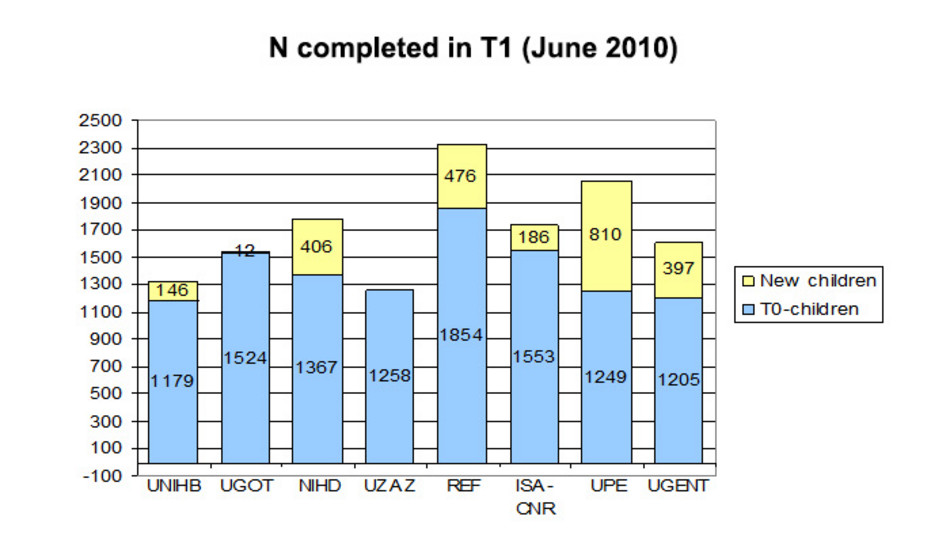Study design & data collection
A cohort of 16 224 children aged 2–9 years from eight European countries (Sweden, Germany, Hungary, Italy, Cyprus, Spain, Belgium and Estonia) participated at the first population-based survey of the IDEFICS study. This first survey, defined as T0, was the baseline of the prospective cohort study with the largest European children’s cohort established to date and also represents the baseline measure for the IDEFICS intervention.
Country | Intervention | Non-Intervention | TOTAL |
|---|---|---|---|
| Germany | 1,179 | 887 | 2,066 |
| Sweden | 902 | 907 | 1,809 |
Estonia | 793 | 926 | 1,719 |
| Spain | 798 | 709 | 1,507 |
| Cyprus | 1,373 | 1,007 | 2,380 |
| Italy | 1,155 | 1,095 | 2,250 |
| Hungary | 1,277 | 1,290 | 2,567 |
| Belgium | 976 | 950 | 1,926 |
| TOTAL | 8,453 | 7,771 | 16,224 |
Study groups and sample size by country at baseline (T0)
A second survey (the follow-up, T1,) reassessed the children 2 years later to determine the associations between possible factors influencing health status observed at baseline and selected follow-up outcomes, and also for assessing short-term effects of the intervention, comparing children from control and intervention areas. By the end of T1 69% (=11,189) of the children who participated at T0 had participated, plus 2,433 new children who entered the corresponding schools or classes between T0 and T1.

Number of children recruited at T1 by country
A selection of morbidities observed at baseline (T0) was used for three retrospective case–control analyses in relation to overweight, insulin resistance (homeostasis model assessment (HOMA) and bone. Finally, a mailed questionnaire was completed by parents at the third survey (T2) to assess the sustainability of the intervention.
Study centre | Country | T0 | T1 | T2 | T0 & T1 | T0 & T1 & T2 |
|---|---|---|---|---|---|---|
| ISA-CNR | Italy | 2,250 | 1,738 | 1,827 | 1,548 | 1,311 |
| NIHD | Estonia | 1,719 | 1,765 | 1,840 | 1,334 | 1,223 |
REF | Cyprus | 2,380 | 2,333 | 1,004 | 1,743 | 680 |
| UGENT | Belgium | 1,926 | 1,725 | 1,204 | 1,253 | 930 |
| UGOT | Sweden | 1,809 | 1,533 | 915 | 1,511 | 886 |
| UNIHB | Germany | 2,065 | 1,341 | 654 | 1,195 | 522 |
| UPE | Hungary | 2,569 | 1,920 | 1,815 | 1,247 | 891 |
| UZAZ | Spain | 1,507 | 1,241 | 1,009 | 1,207 | 971 |
| TOTAL | 16,225 | 13,596 | 10,268 | 11,038 | 7,414 |
Number of children eligible for analysis by country and time of examination; the last two columns give the number of children for whom measurements are available for the first two and for all three examinations, respectively
First results regarding the prevalence of overweight and obesity stratified by sex and country are displayed in the figures below. These results reveal a substantial variation of the corresponding prevalence values across study regions, with higher values in the South of Europe as compared to the North:

Many children of the IDEFICS study and their families participated in the I.Family study in 2013/2014. Further follow-up studies are being conducted as part of the longitudinal IDEFICS/I.Family cohort.
For learning about the study design of IDEFICS in detail we recommend following articles:
- Ahrens W, Bammann K, Siani A, Buchecker K, De Henauw S, Iacoviello L, et al. The IDEFICS cohort: design, characteristics and participation in the baseline survey. Int J Obes (Lond). 2011;35 Suppl 1:S3-15.
http://www.nature.com/ijo/journal/v35/n1s/full/ijo201130a.html - Ahrens W, Siani A, Adan R, De Henauw S, Eiben G, Gwozdz W, et al. Cohort Profile: The transition from childhood to adolescence in European children-how I.Family extends the IDEFICS cohort. Int J Epidemiol. 2016:dyw317-dyw.
http://ije.oxfordjournals.org/content/early/2016/12/31/ije.dyw317.extract
For the complete Final Publishable Report click here


